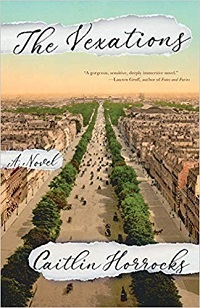date newest »
newest »
 newest »
newest »
 Thanks, Gary, for your comments and the museum recommendation. I would love to visit in person. The descriptions of Honfleur and Le Havre in the novel were memorable. I've visited Normandy before but not either place.
Thanks, Gary, for your comments and the museum recommendation. I would love to visit in person. The descriptions of Honfleur and Le Havre in the novel were memorable. I've visited Normandy before but not either place.I'll have to pull out my copy of Devil in Montmartre to find Satie now! At the time I read it, I didn't know who he was, so the cameo must have passed me by :)
 Sarah wrote: "Thanks, Gary, for your comments and the museum recommendation. I would love to visit in person. The descriptions of Honfleur and Le Havre in the novel were memorable. I've visited Normandy before b..."
Sarah wrote: "Thanks, Gary, for your comments and the museum recommendation. I would love to visit in person. The descriptions of Honfleur and Le Havre in the novel were memorable. I've visited Normandy before b..."You're welcome, Sarah. Apropos Honfleur and Le Havre, they figure prominently in the denouement of my third Inspector Lefebvre mystery, "The Man Upon the Stair."
Regarding Satie's cameo in "Devil", it's brief enough to cite here:
Sir Henry watched Émile go out the door, then turned to Lautrec. “Poor fellow. I diagnose a case of Virginie on the brain. I suppose he’s sweet on her.” Lautrec muttered, “Perhaps.” He turned his attention to a slender man walking toward the piano. “You see the man who’s about to play?” Sir Henry screwed a monocle into his eye and gazed across the smoke-filled hall. “Yes; who is he?” “His name’s Satie; not bad, really. The crowd listens when he plays.”
Inbinder, Gary. The Devil in Montmartre: A Mystery in Fin de Siècle Paris (p. 32). Pegasus. Kindle Edition.
 I hope that you are able to visit Honfleur and Le Havre someday, Sarah. Many immigrant ancestors of Americans left through the port of Le Havre in the 19th century (Satie's time!), including many Germans and Austrians, in addition to French and Belgians and others. It's fun to see those two cities and pretend to be looking through our ancestors' eyes as they took that big step toward America.
I hope that you are able to visit Honfleur and Le Havre someday, Sarah. Many immigrant ancestors of Americans left through the port of Le Havre in the 19th century (Satie's time!), including many Germans and Austrians, in addition to French and Belgians and others. It's fun to see those two cities and pretend to be looking through our ancestors' eyes as they took that big step toward America.
 Thanks for that information, Alex - I hadn't realized Le Havre was such a large emigration port, but that makes sense given its location. I hope so too!
Thanks for that information, Alex - I hadn't realized Le Havre was such a large emigration port, but that makes sense given its location. I hope so too!
 A century ago my mother's family--my grandparents, mother, uncles and aunt--immigrated to the US on The French Line's La Lorraine, which made regular transatlantic runs from Le Havre to New York.
A century ago my mother's family--my grandparents, mother, uncles and aunt--immigrated to the US on The French Line's La Lorraine, which made regular transatlantic runs from Le Havre to New York.Here's another cite from one of my Inspecter Lefebvre novels, this time taken from a section describing the Le Havre docks ca. 1890:
The dockland appeared like a waterfront forest overgrown with tall masts and towering cranes. The place echoed with the sound of steam whistles on vessels of various types, sizes, and national origins and from stationary engines powering the derricks that hoisted tons of freight, loading and emptying the vast cargo holds. The world’s produce—raw materials, finished goods, and foodstuff—flowed into and out from the bustling entrepôt. An immense amount of human traffic also passed through the port, many bound for the Americas aboard the great French Line steamers.
Inbinder, Gary. The Man Upon the Stair: A Mystery in Fin de Siecle Paris . Pegasus Books. Kindle Edition.





https://www.ot-honfleur.fr/je-profite...
P.S. Satie makes a brief cameo appearance in The Devil in Montmartre. ;)